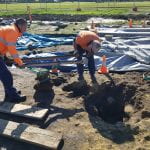Stripping, machining, mechanical excavation. All describe the process of getting a machine to do the work for us. However, unlike job automation or the rise of sentient AI, machining aids our process – rather than threatens to replace us. Getting an operator in an excavator to carefully pare back topsoil or layers of undiagnostic fill material can save the archaeologist valuable time, freeing up resources for features and deposits which can provide us with the greatest return of information.
Archaeologists spend a surprising amount of time monitoring machines: from small 5-tonne babies, to massive 30-tonne behemoths. Usually this is when working for industry, part of a commercial unit facilitating development. As many archaeologists learn, monitoring machines is 90% boredom and 10% terror. Boredom because you spend a lot of time standing in the rain/snow/wind/heat waiting for something to happen. Terror because you are only one bucket-scoop away from taking a chunk out of something important and irreplaceable – or an unlocated service. Machining is often deployed in urban settings, where development over hundreds of years can result in huge accretions of fill, demolition material and occupation layers. It is also deployed on greenfield sites, where hundreds – sometimes thousands – of metres of strip trenches are cut through nice landscapes to sample their archaeological potential.
At Port Arthur we deployed PAHSMA’s excavator to help us remove the topsoil. Under the careful hand of Gareath, the overlying sediment was machined away. In most cases, this revealed the upper layers of demolition debris – the result of salvage and bushfire in the late 19th century. However, some in situ features also peeked through: sandstone and brick footings, a mortar surface and the mysterious round feature.



